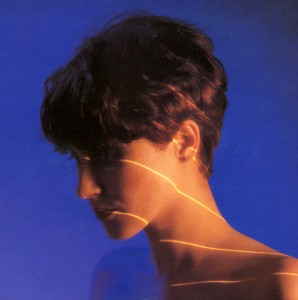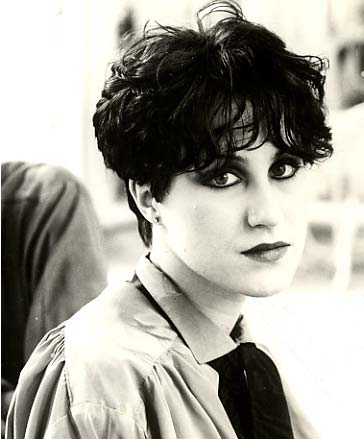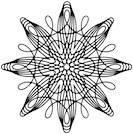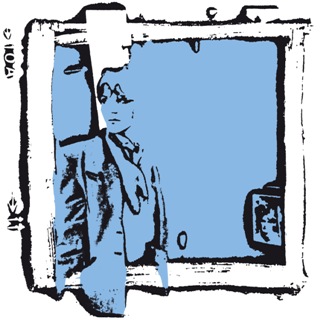Pauline Murray \ Biography
Pauline Murray and Robert Blamire first came to prominence as the lead singer and bass guitarist of pioneering punk band Penetration. From Ferryhill in County Durham, the group played at the legendary Roxy in January 1977 during the first hundred days, after which their exciting live shows and demos led to Virgin Records releasing anthemic single Don't Dictate. Two albums - Moving Targets and Coming Up For Air both sold respectably, while the band built up a dedicated live following and toured America for five weeks in the summer of 1979.
Five very long weeks indeed. "We were exhausted," says Murray today. "And by that time tensions were mounting between various members of the band. Some people were just taking what they could out of it." A split became inevitable, and was announced onstage at Newcastle City Hall on 14th October. "I never wanted to be in Penetration and to be worrying all the time," Pauline confided to the NME. "I wanted it to be fun, not to be always thinking of hit singles and cracking America and writing for the next LP. It brings it down to the level of having a job."
Ironically, Tony Parsons and Julie Burchill had urged Murray to split up Penetration a full year earlier. In The Boy Looked At Johnny, an acerbic punk tome puffed as the obituary of rock and roll, the polemical pair had insisted that: "Pauline's best bet would be to take her musicians out of circulation for a year or two until punk is nothing more than nostalgia music, and then display that extraordinary soaring, searing voice to the public afresh."
At the beginning of January 1980 Murray and Blamire travelled down to London for a meeting with Virgin, both assuming that their recording contract would be renewed. Instead the duo were offered a one-off single, and one last shot at a solid chart hit. "They said we'd have to get a single in the Top 30 before they would finance another album," recalls the singer of this inauspicious start to the new decade. "We told them to stuff it."
Penetration's last hurrah turned out to be Race Against Time, an official bootleg comprising demo versions and tracks from the farewell show at Newcastle City Hall. Despite having dropped the group, however, Virgin laid claim to the material, resulting in an awkward co-release in January 1980. Weary of major label machinations, and impressed by the way in which peers such as Stiff Little Fingers and Joy Division had established viable careers on independent labels during 1979, Murray now decided to take charge of her own vinyl destiny - and on her own terms. "Solo career makes me cringe," she insists. "The reason things then came out under my name is that we didn't want another permanent group. We both felt hampered by that sort of situation."
At the beginning of 1980 Murray and Blamire began writing a clutch of new songs, including Sympathy, Shoot Your Down, and When Will We Learn. Best of all, however, was Dream Sequence, written by Murray alone with the string part of Street Hassle by Lou Reed in mind, as well as Abba and "a very airy sort of European pop." The first the public would hear of this bold new musical direction was a John Peel radio session recorded in March, featuring all four songs, on which Murray and Blamire were joined by Cowboys International guitarist Alan Rawlins, and Peter Howells of The Drones on drums.
Already, in February, the pair had approached legendary producer Martin 'Zero' Hannett, then at the height of his Spector-esque renown, having overseen four classic post-punk albums in little more than a year. Unknown Pleasures by Joy Division and The Return of the Durutti Column had already appeared, while Closer and The Correct Use of Soap by Magazine were virtually complete. "I only knew Martin from what he'd produced," says Murray of the singular, storied Mancunian. "He just seemed to have a knack of putting things in the right setting. We also really liked what he did behind John Cooper Clarke with Steve Hopkins. With the Invisible Girls you had all the advantages of a readymade band, but none of the pitfalls of a permanent association."
"We first met Martin at his flat in Didsbury," recollects Blamire. "He'd just finished mixing Atmosphere and I remember being blown away listening to it on his Revox reel to reel through these incredible, massive Quad electrostatic speakers. We played him our demos and explained what we wanted, and he agreed to the project. He could hear the potential in the songs and the lack of a band gave him a free reign to add his production and instrumentation."
However, Hannett and Strawberry Studios cost money. After duetting with Peter Perrett of The Only Ones on a single, Fools, Murray talked to CBS, but ultimately settled on a licensing deal with RSO Records, owned by media mogul Robert Stigwood, and still somewhat tainted by association with the Bee Gees, Grease and Saturday Night Fever. The terms of the agreement included an advance to fund an album, and their own bespoke imprint: Illusive. "RSO were so unfashionable that it sort of perversely appealed to me," laughs Murray. "But they also left us with the final say over all the important things. They had a new head of A&R, Ashley Newton, whose brief was to develop a more contemporary, British side to the roster. He also signed The Associates for a one-off single, Kites. It was totally different to the way we'd worked before, and they gave us got a better deal than we'd ever expected."
Hannett and Hopkins recorded Dream Sequence at Strawberry in April, still with Alan Rawlins on guitar, and session drummer Trevor Spencer. Karl Burns of The Fall had been Hannett's original choice, but his performance wasn't used. Meanwhile Blamire became an honorary Invisible Girl. "We decided to do that single and see how it went," Pauline told NME. "Martin works in a totally different way to any other producer we've recorded with. He doesn't even re-play songs on the tape very much. He has it all in his head. I'd been stuck in a rut and I need something like that to show me some sort of light. Martin was just the right person."
Dream Sequence was issued in July on 7" and 10", tastefully sleeved by Factory design director Peter Saville, with appropriately Surrealistic monochrome portraits of Murray by photographer Trevor Key, in the style of Man Ray. Unfortunately the breezy single climbed no higher than #67 on the British chart; in any event, Top of the Pops was on strike. "I would have liked to have seen it in there," rued Pauline in Record Mirror, "but it sold more than the Penetration records. The charts are nothing to be ashamed of. When we talk about the pop songs we're doing, it's not particularly middle of the road pop."
"The songs of the old band were written by five people," added Blamire. "We never really wrote any of the heavier songs."
Even as the single was released, album sessions began with Hannett and Hopkins at Strawberry and lasted four weeks. By now Murray and Blamire had completed a dozen original songs, to which was added Time Slipping, an existing Invisible Girls backing track with lyrics by Murray. From this newer material the metallic disco of Mr X and elegiac album closer Judgement Day in particular stood out as breaking fresh ground. "As we're going on, the songs are becoming deeper musically and lyrically" offered Blamire. "The songs Pauline was writing just after the split reflected what was happening then. The songs we've done more recently reflect what's happening now. They're very different."
"A lot of the new songs are not as riffy as the old stuff," added Pauline. "So we might lose a lot of the hard-core punks. I don't think you should ever rely on an audience. And I don't think you should play to your audience's expectations. Dream Sequence paved the way. It let people know it wasn't like Penetration, it made people make up their minds about whether they were interested or not."
The most radical departure was surely Mr X, a track more at home in the Blitz club or Studio 54 than the Roxy or the Vortex. Says Blamire: "Mr X started life as a backing track influenced by the John Martyn album One World, which includes contributions from Lee Perry. The percussion track features - teaspoon in a glass, a wooden ruler, and a swan whistle. The electronic percussion came later in the recording process. Unusually, I also contributed guitar."
Besides Hannett, Hopkins and Blamire, the 'invisible girls' backing Murray included John Maher of Buzzcocks on drums, and exotic percussionist Dave Hassell. Durutti Column maestro Vini Reilly also contributed guitar, with his signature sound unmistakeable on Drummer Boy and When Will We Learn. Dave Rowbotham, a former colleague of Reilly in Durutti, also contributed heavier textured guitar, while Hopkins handled most of the keyboards and piano.
"Martin's a weird bloke but we work really well with him," Murray told NME. "We work through the night and at first it seemed that we were getting nothing done by doing it that way. It took a while to come to terms with it. But then you look at what you've actually completed and it's a hell of a lot. He just put a whole new aspect on things... More experimenting, more actual depth to what's there."
"Pauline's album was recorded at a pivotal time in Martin's career," says Steve Hopkins. "It fused great live musicians with all the options offered by new studio toys and synths. These were the days just before many producers - including Martin - became infatuated with click tracks, sequencers and SMPTE code. So the rhythm tracks were laid down at once with a five piece: guitar, piano, bass, drums and Pauline's guide vocals. This ensured that we got the all-important feel and dynamics as a basis, usually within half a dozen takes. We probably managed two basic tracks each studio day. Then the Invisible Girls and Pauline would lay down lots of parallel overdubs, leaving Martin with way, way too many wonderful options when it came to the final mix. Martin's then-current obsession was individual sonic spaces for different sounds using EQ and glassy digital reverb. At the mix-down it sounded amazing with the extreme clarity offered by his home audio set-up of double Quad electrostatic speakers (two on each side)."
"The album was recorded much like any other to start with," says Blamire. "John Maher, Steve Hopkins and myself put down the backing tracks. Then things got a bit weird. Vini came in without having heard any of the material before and did his thing. Later, on closer inspection of the multi-track tapes, Martin had recorded up to six tracks of guitar from one take. Steve spraying Pledge polish aerosol into a U87 microphone made for another memorable percussion track. The album definitely changed my life."
Murray found the sessions somewhat harder to negotiate. "I went through a really weird stage when we were recording the album," she told Sounds. "The first week was really strange. I couldn't talk to anyone. People would say things and I wouldn't look at them. I couldn't even ring for a taxi to take us anywhere, I'd get on the phone and I couldn't speak."
In fact the issues ran deeper, and were exacerbated by the fact that she and Blamire were lodging with Hannett in Didsbury at the time (the chaotic kitchen pictured in the Pennie Smith photo session is his). "I had to leave for a bit after a week," Pauline admits today. "It just felt like I was losing control of my own album. Martin would get me to do about ten different vocals takes for each track, but he never gave me any feedback or guidance. It really undermined my confidence, and I couldn't tell whether or not I even liked what I was hearing. Everything that had gone on over the previous four years came to the forefront on this record. So much had happened, and I was still only 22 years old."
Released at the end of September, the album entered the British national chart at #35, and drew rave reviews from the critics. "A musical high point of this year, or any other," offered Melody Maker, discerning "an exciting new area of electronic pop where Motown meets the modern world." NME writer Paul Morley found himself in complete agreement. "Murray and Blamire have produced something that's a mighty long way from punk. Lovely songs of anxiety, malaise and self-doubt. Pauline Murray sings of the love of love, fear of fear, or suspicion and retribution, and consistently captures the drama in a dream. Hannett's production is cracking, ornate yet never opaque, discretely echoed and gently warped to the point of hallucination."
While studiously avoiding the magic (or dirty) word pop, Morley judged the album great entertainment. "This is sophistication, and it's nothing to be ashamed of. There is no pretence that a ragged edge of a discordant solo is the password to credibility. The music is wildly eclectic - look for Chic slick, Springsteen hope and glory, Wonder resource, gothic spaciousness, post-punk passion. Murray's personal touches, the quiet fire of her bewilderment and almost lullaby-like disillusionment transforming it into a great work of passion."
Sounds also deemed the album "meta-commercial", John Gill singling out the "yearning, intelligent pop" of Thundertunes and "strung-out funky" Mr X for special praise. "I only hope that her benefactors at RSO aren't planning to make her the Yvonne Elliman of the Joy Division era." Record Mirror reviewed the album in tandem with Kilimanjaro by The Teardrop Explodes, released that same week. "This is pop!" raved Chris Westwood, awarding five stars. "Think of the most addictive Abba and the most positive Joy Division, and these songs have an effect somewhere in between, very pretty but very hard. Hannett's drum snap is there, but it's also among his warmest, most sympathetic works, providing the airy, breathy support a voice like Pauline Murray's cries out for."
Other mould-breaking post-punk pop albums released at more or less the same time included The Affectionate Punch by The Associates (now on Polydor faux-indie Fiction), and Empires and Dance by Simple Minds, still struggling to break through on Arista. Pauline Murray and the Invisible Girls thus found itself in excellent company, albeit a year or so ahead of its time. "It's a bit of a missing link album really," muses Pauline today. "Written and recorded after punk, but before the Human League and Martin Rushent - the other Martin - made pure pop respectable again."
Mr X made for a smart choice as the second single, backed by non-album track Two Shots. By way of live promotion fans were treated to a 'Girls Night Out' tour at the beginning of October, featuring John Cooper Clarke as well as Murray, with both artists backed by various permutations of the Invisible Girls. Hopkins and Reilly played both sets, with Reilly also performing a short interval set as Durutti Column at selected shows. With John Maher unavailable, Paul Burgess of 10CC took over on drums, while Hannett - seated - played bass behind Cooper Clarke. The tour kicked off in Dundee on the 3rd, and wound up in Aylesbury nine dates later, most of which were sold out.
Murray's headline set eschewed old Penetration songs entirely. "She sang superbly," wrote Frank Worrall of the Manchester Apollo show. "Living out the emotion behind the songs, balanced on the one hand between raw edged screams and soulful touching chords on the other. Could Pauline Murray and the Invisible Girls effectively translate the power and feeling of their stunning debut album into the live arena? Any fears that they couldn't were rapidly dispelled."
"Her pairing with the phantoms of Factory was an inspired stroke and the album is undoubtedly one of the year's best," agreed Adrian Thrills of NME, who caught the show at the London Lyceum. "Onstage, Pauline is far more relaxed and assured than in her Penetration days, giving full vent to her superb vocal range while losing little of her gritty northern soul intensity."
"The joint tour happened at an interesting time in all our lives," says musical director Steve Hopkins. "Pauline was touring her new lyrical persona for the first time, to an audience made up equally of new fans and her old Penetration following, and JCC was performing poetry with rock music. It was terrifically exciting tour because all the venues were sold out. Optimism was high and all the musicians were highly skilled. Some like Pauline, Robert, Vini and Martin had existing street cred, some had a more mainstream profile like Paul Burgess, but surprisingly everyone got along. Apart from his formative years, this was the only time that Martin ever got on the large stage, contributing 'ambient guitar thickenings' to JCC's backing tracks. At the end of the tour the band gave me a small pair of gold candelabra to keep on my piano as a gesture of thanks, which I still treasure today."
The Invisible Girls also crossed to Brussels to perform several songs on Belgian television show Follies (available to watch on YouTube), and played Dream Sequence on Granada TV show Fun Factory. Thanks to the album and tour Murray featured prominently in the British music press throughout the autumn on 1980, and would make the Top Ten list of best female vocalists in most end of year polls. A different kind of flattery came with high rankings in several "sexiest female" listings. "I wanted the album kept low key and quiet," Murray admitted in a piece for a compendium book on New Women in Rock. "Because, having noted the extent to which other people are prepared to go, I am determined not to do likewise." That said, it's fair to say that photogenic former art student Murray was very much a visible girl in 1980, having perfected a cool, androgynous style partly influenced by French artist Lizzy Mercier Descloux, and which has barely dated at all.
Disappointingly, the only overseas territories to release the album were Japan and Scandinavia. Indeed the conclusion of the Girls Night Out tour marked the beginning of a five month hiatus, during which Murray and Blamire wrote new songs, and Blamire worked with Scots post-punk band Scars, producing their first (and only) album, Author! Author! There was also the small matter of assembling a new gang of Invisible Girls. "Steve and Vini weren't available for live shows the following year," explains Murray. "Plus we decided that we probably needed someone more permanent on guitar after all."
An ad placed in Melody Maker delivered up Wayne Hussey, a native of Bristol who'd moved up to Liverpool. "Wayne was very clean cut and preppy-looking back then," laughs Murray. "Into Talking Heads and David Byrne. He was brought up as a Mormon, so he didn't smoke or drink. Then John Maher introduced him to the rock' n' roll lifestyle..." A very different Wayne Hussey would later find fame in Dead or Alive, Sisters of Mercy and The Mission.
With new boy Hussey on guitar, and Hopkins and Maher returning on keyboards and drums, Murray and Blamire went back into the studio in March 1981. Lead track Searching for Heaven was a poised, punchy pop song co-written by Murray and Hussey, while the sequenced electronic textures applied by Hannett to Animal Crazy share much in common with early New Order. Indeed Bernard Sumner added a short guitar solo at the close of Searching for Heaven. "We'd run over at Strawberry and New Order were waiting upstairs," explains Pauline. "Martin asked Bernard to do the solo so it was totally spontaneous. He'd never even heard the track before." The mixdown of the single also featured on North West television show Granada Reports, with Hannett quizzed by Tony Wilson on the intricacies of EQ, gates and "parametric mid-ranges".
Searching for Heaven was speedily released on 7" and 10" in April by RSO, sleeved by Factory alumnus Martyn Atkins. Vaughan Oliver (a classmate of Pauline at school) also produced an artful teeshirt design prior to making his name at 4AD. Already the new group had completed a lengthy European tour in March, taking in Scandinavia, Germany and France, with two shows in the Netherlands broadcast on national radio. Back in Britain, a nine date tour of colleges and town halls bridged April and May, including another headline show at the Lyceum in London, this time supported by fast rising Blitz kids Duran Duran.
However, Searching for Heaven was not a hit, and RSO was now beset by financial difficulties. For Murray, too, there followed a period of personal turmoil. "I split up with my husband," she explains. "It was only then that me and Robert became a couple in the romantic sense. We moved across the country to Liverpool just to get away from it all. Princess Avenue, Toxteth. And the next week there were riots. I thought, `My God! This is all we need!' That was a weird year."
Not for nothing would their next project be released as Pauline Murray and the Storm. "I suppose you could say I suffered a personal crisis which took my attention away from music. But I chose to be absent. I was unhappy with the new songs, and it seemed pointless to continue when I was so lacking in self-confidence." Thankfully the singer would eventually return in 1984 with an electronic cover version of Alex Chilton's bruised and bruising song Holocaust, released on a new imprint that the pair named Polestar. "Rob and I eventually moved back to Newcastle without a recording contract or management," Pauline explains. "I began to pick up the pieces of what felt like a shattered life, and lyrically Holocaust reflected how I was feeling at the time. We really were out on our own by then, and it's stayed that way ever since."
Murray and Blamire put together a new version of Penetration in 2001, but are delighted to see Pauline Murray and the Invisible Girls back in print. "It's been lost in the darkness for far too long," reflects Pauline. "Looking back, it seems amazing that the album ever existed in the first place. It encapsulates disillusionment with what punk had become, my own progress as a singer, lyricist and songwriter, the transient nature of the music industry, and the coming together of certain musicians and Martin Hannett in a time and space for a unique project, never to be repeated."
Liner notes by James Nice





![Pauline Murray and the Invisible Girls [TWI 016]](images/twi016cd.jpg)

![V/A - The Cold Open [TWI 1254]](../images/twi12541.jpg)
